Connect With Us
Blogs
Blog
Hammertoe Havoc
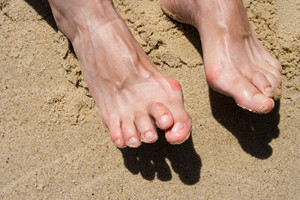 Hammertoe is caused when there is a muscle and ligament imbalance around the toe joint. This causes the middle joint of the toe to bend and become stuck in this position . Many people with hammertoe complain about rubbing and irritation at the top of the bent toe. Toes that tend to unnaturally curl, such as the baby toe, are also considered hammertoes. “Flexible” and “Rigid” are the two main types of hammertoes. If the toe can still be moved around, it is considered a flexible hammertoe. Hammertoes that don’t allow for any toe movement are classified as rigid hammertoes.
Hammertoe is caused when there is a muscle and ligament imbalance around the toe joint. This causes the middle joint of the toe to bend and become stuck in this position . Many people with hammertoe complain about rubbing and irritation at the top of the bent toe. Toes that tend to unnaturally curl, such as the baby toe, are also considered hammertoes. “Flexible” and “Rigid” are the two main types of hammertoes. If the toe can still be moved around, it is considered a flexible hammertoe. Hammertoes that don’t allow for any toe movement are classified as rigid hammertoes.
Hammertoe
Hammertoes can be a painful condition to live with. For more information, contact Dr. Michael D. Garvin from Florida. Our doctor will answer any of your foot- and ankle-related questions.
Hammertoe is a foot deformity that affects the joints of the second, third, fourth, or fifth toes of your feet. It is a painful foot condition in which these toes curl and arch up, which can often lead to pain when wearing footwear.
Symptoms
- Pain in the affected toes
- Development of corns or calluses due to friction
- Inflammation
- Redness
- Contracture of the toes
Causes
Genetics – People who are genetically predisposed to hammertoe are often more susceptible
Arthritis – Because arthritis affects the joints in your toes, further deformities stemming from arthritis can occur
Trauma – Direct trauma to the toes could potentially lead to hammertoe
Ill-fitting shoes – Undue pressure on the front of the toes from ill-fitting shoes can potentially lead to the development of hammertoe
Treatment
Orthotics – Custom made inserts can be used to help relieve pressure placed on the toes and therefore relieve some of the pain associated with it
Medications – Oral medications such as anti-inflammatories or NSAIDs could be used to treat the pain and inflammation hammertoes causes. Injections of corticosteroids are also sometimes used
Surgery – In more severe cases where the hammertoes have become more rigid, foot surgery is a potential option
If you have any questions please contact our offices located in Port St. Lucie, FL . We offer the newest diagnostic and treatment technologies for all your foot and ankle needs.
How Stress Fracture Healing Time May Be Linked to BMI
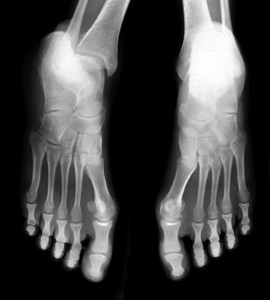 A research team at Ohio State University spent three years studying the relationship between stress fractures and the required healing time to return to running on a Division 1 team. The team was able to find that the average healing time of a Grade V stress fracture was 17 weeks. A Grade V stress fracture is a fracture that is often ignored or mistreated to the point where surgery is required. These researchers compared the BMIs of women who were injured with those who were not, and found that women with BMIs lower than 19 were at a higher risk of developing stress fractures.
A research team at Ohio State University spent three years studying the relationship between stress fractures and the required healing time to return to running on a Division 1 team. The team was able to find that the average healing time of a Grade V stress fracture was 17 weeks. A Grade V stress fracture is a fracture that is often ignored or mistreated to the point where surgery is required. These researchers compared the BMIs of women who were injured with those who were not, and found that women with BMIs lower than 19 were at a higher risk of developing stress fractures.
Activities where too much pressure is put on the feet can cause stress fractures. To learn more, contact Dr. Michael D. Garvin from Florida. Our doctor can provide the care you need to keep your pain free and on your feet.
Dealing with Stress Fractures of the Foot and Ankle
Stress fractures occur in the foot and ankle when muscles in these areas weaken from too much or too little use. The feet and ankles then lose support when walking or running from the impact of the ground. Since there is no protection, the bones receive the full impact of each step. Stress on the feet can cause cracks to form in the bones, thus creating stress fractures.
What Are Stress Fractures?
Stress fractures occur frequently in individuals whose daily activities cause great impact on the feet and ankles. Stress factors are most common among:
- Runners
- People affected with Osteoporosis
- Tennis or basketball players
- Gymnasts
- High impact workouts
Symptoms
Pain from the fractures occur in the area of the fractures and can be constant or intermittent. It will often cause sharp or dull pain with swelling and tenderness. Engaging in any kind of activity which involves high impact will aggravate pain.
If you have any questions please feel free to contact our offices located in Port St. Lucie, FL . We offer the newest diagnostic and treatment technologies for all your foot and ankle needs.
What is Athlete’s Foot?
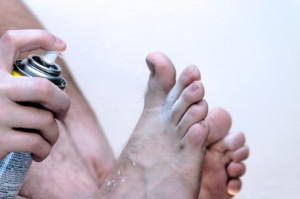 Athlete’s foot, also known as tinea pedis, is a common fungal infection. Symptoms of the condition include itchiness, redness, flaking, and scaly skin. Although a variety of different fungi may cause athlete’s foot, they all thrive on moisture. The condition spreads through contact with the fungi itself or contact with infected skin. Areas such as damp locker rooms, bathroom floors, showers, and swimming pools are all prime breeding areas for the fungi. If you want to prevent yourself from getting athlete’s foot, you should be sure to wash all socks, towels, bath mats, and sheets that may have come in contact with the infection. Another tip is to always make sure you wear shower shoes while walking in moist areas. Keeping your feet warm and dry will also help prevent athlete’s foot.
Athlete’s foot, also known as tinea pedis, is a common fungal infection. Symptoms of the condition include itchiness, redness, flaking, and scaly skin. Although a variety of different fungi may cause athlete’s foot, they all thrive on moisture. The condition spreads through contact with the fungi itself or contact with infected skin. Areas such as damp locker rooms, bathroom floors, showers, and swimming pools are all prime breeding areas for the fungi. If you want to prevent yourself from getting athlete’s foot, you should be sure to wash all socks, towels, bath mats, and sheets that may have come in contact with the infection. Another tip is to always make sure you wear shower shoes while walking in moist areas. Keeping your feet warm and dry will also help prevent athlete’s foot.
Athlete’s foot is an inconvenient condition that can be easily reduced with the proper treatment. If you have any concerns about your feet and ankles, contact Dr. Michael D. Garvin from Florida. Our doctor will treat your foot and ankle needs.
Athlete’s Foot: The Sole Story
Athlete's foot, also known as tinea pedis, can be an extremely contagious foot infection. It is commonly contracted in public changing areas and bathrooms, dormitory style living quarters, around locker rooms and public swimming pools, or anywhere your feet often come into contact with other people.
Solutions to Combat Athlete’s Foot
- Hydrate your feet by using lotion
- Exfoliate
- Buff off nails
- Use of anti-fungal products
- Examine your feet and visit your doctor if any suspicious blisters or cuts develop
Athlete’s foot can cause many irritating symptoms such as dry and flaking skin, itching, and redness. Some more severe symptoms can include bleeding and cracked skin, intense itching and burning, and even pain when walking. In the worst cases, Athlete’s foot can cause blistering as well. Speak to your podiatrist for a better understanding of the different causes of Athlete’s foot, as well as help in determining which treatment options are best for you.
If you have any questions please feel free to contact our offices located in Port St. Lucie, FL . We offer the newest diagnostic and treatment technologies for all your foot and ankle needs.
Padres Shortstop Suffers Foot Fracture
 In a game against the San Francisco Giants, Padres shortstop Erick Aybar suffered a fracture in his foot. Although he was able to stay in the game, he sat out for the rest of the series due to the injury. It is possible that the shortstop could miss the remainder of the season as a result of the fracture. Shortstop has been one of the least productive positions for the struggling 2017 Padres, but they are expected to look to their minor league system in order to find Aybar’s replacement. Going forward, Dusty Coleman and Allen Cordoba are expected to be frontrunners in terms of manning the shortstop position in Aybar’s absence.
In a game against the San Francisco Giants, Padres shortstop Erick Aybar suffered a fracture in his foot. Although he was able to stay in the game, he sat out for the rest of the series due to the injury. It is possible that the shortstop could miss the remainder of the season as a result of the fracture. Shortstop has been one of the least productive positions for the struggling 2017 Padres, but they are expected to look to their minor league system in order to find Aybar’s replacement. Going forward, Dusty Coleman and Allen Cordoba are expected to be frontrunners in terms of manning the shortstop position in Aybar’s absence.
A broken foot requires immediate medical attention and treatment. If you need your feet checked, contact Dr. Michael D. Garvin from Florida. Our doctor can provide the care you need to keep you pain-free and on your feet.
Broken Foot Causes, Symptoms, and Treatment
A broken foot is caused by one of the bones in the foot typically breaking when bended, crushed, or stretched beyond its natural capabilities. Usually the location of the fracture indicates how the break occurred, whether it was through an object, fall, or any other type of injury.
Common Symptoms of Broken Feet:
- Bruising
- Pain
- Redness
- Swelling
- Blue in color
- Numbness
- Cold
- Misshapen
- Cuts
- Deformities
Those that suspect they have a broken foot shoot seek urgent medical attention where a medical professional could diagnose the severity.
Treatment for broken bones varies depending on the cause, severity and location. Some will require the use of splints, casts or crutches while others could even involve surgery to repair the broken bones. Personal care includes the use of ice and keeping the foot stabilized and elevated.
If you have any questions please feel free to contact our offices located in Port St. Lucie, FL . We offer the newest diagnostic and treatment technologies for all your foot and ankle needs.
Daily Tips for Healthy Feet
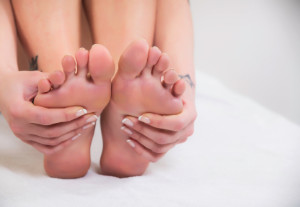 When we use our feet everyday, it is almost impossible to avoid feeling soreness in them every once in awhile. Fortunately, there are ways you can help alleviate some of the pain you may be feeling after a long day of walking. Drinking green tea can help your body relax, and it will also give you the antioxidants needed to reduce inflammation. If the rest and relaxation isn’t enough, you may find that a massage may be useful. You can try placing a foam roller on the floor and moving it back and forth with your foot in order to gently massage it. These foam rollers may be used while hot or cold, and they will help with any pain or soreness you are feeling.
When we use our feet everyday, it is almost impossible to avoid feeling soreness in them every once in awhile. Fortunately, there are ways you can help alleviate some of the pain you may be feeling after a long day of walking. Drinking green tea can help your body relax, and it will also give you the antioxidants needed to reduce inflammation. If the rest and relaxation isn’t enough, you may find that a massage may be useful. You can try placing a foam roller on the floor and moving it back and forth with your foot in order to gently massage it. These foam rollers may be used while hot or cold, and they will help with any pain or soreness you are feeling.
Everyday foot care is very important to prevent infection and other foot ailments. If you need your feet checked, contact Dr. Michael D. Garvin from Florida. Our doctor can provide the care you need to keep you pain-free and on your feet.
Everyday Foot Care
Often, people take care of their bodies, face and hair more so than they do for their feet. But the feet are a very important aspect of our bodies, and one that we should pay more attention to. Without our feet, we would not be able to perform most daily tasks.
It is best to check your feet regularly to make sure there are no new bruises or cuts that you may not have noticed before. For dry feet, moisturizer can easily be a remedy and can be applied as often as necessary to the affected areas. Wearing shoes that fit well can also help you maintain good foot health, as well as making it easier to walk and do daily activities without the stress or pain of ill-fitting shoes, high heels, or even flip flops. Wearing clean socks with closed shoes is important to ensure that sweat and bacteria do not accumulate within the shoe. Clean socks help to prevent Athlete’s foot, fungi problems, bad odors, and can absorb sweat.
If you have any questions please feel free to contact our offices located in Port St. Lucie, FL . We offer the newest diagnostic and treatment technologies for all your foot and ankle needs.
Foot Care and Diabetes
 Foot care is extremely important to diabetics as they often suffer from neuropathy and poor blood circulation in the feet. With this in mind, if you are diabetic, always maintain proper foot care. Wear shoes that are comfortable and provide adequate support for your feet. If you travel, be sure to bring different pairs of shoes so that you have multiple options for different terrains. Twice a day, look at your feet to see if there are any abnormalities such as redness, numbness, or a wound. Wash your feet daily as well and keep them as clean as possible. Finally, maintain a healthy diet and closely monitor your blood glucose levels. If you feel pain in your feet or notice any abnormalities, see a podiatrist for a consultation.
Foot care is extremely important to diabetics as they often suffer from neuropathy and poor blood circulation in the feet. With this in mind, if you are diabetic, always maintain proper foot care. Wear shoes that are comfortable and provide adequate support for your feet. If you travel, be sure to bring different pairs of shoes so that you have multiple options for different terrains. Twice a day, look at your feet to see if there are any abnormalities such as redness, numbness, or a wound. Wash your feet daily as well and keep them as clean as possible. Finally, maintain a healthy diet and closely monitor your blood glucose levels. If you feel pain in your feet or notice any abnormalities, see a podiatrist for a consultation.
Everyday foot care is very important to prevent infection and other foot ailments. If you need your feet checked, contact Dr. Michael D. Garvin from Florida. Our doctor can provide the care you need to keep you pain-free and on your feet.
Everyday Foot Care
Often, people take care of their bodies, face and hair more so than they do for their feet. But the feet are a very important aspect of our bodies, and one that we should pay more attention to. Without our feet, we would not be able to perform most daily tasks.
It is best to check your feet regularly to make sure there are no new bruises or cuts that you may not have noticed before. For dry feet, moisturizer can easily be a remedy and can be applied as often as necessary to the affected areas. Wearing shoes that fit well can also help you maintain good foot health, as well as making it easier to walk and do daily activities without the stress or pain of ill-fitting shoes, high heels, or even flip flops. Wearing clean socks with closed shoes is important to ensure that sweat and bacteria do not accumulate within the shoe. Clean socks help to prevent Athlete’s foot, fungi problems, bad odors, and can absorb sweat.
If you have any questions please feel free to contact our offices located in Port St. Lucie, FL . We offer the newest diagnostic and treatment technologies for all your foot and ankle needs.
What Causes a Stress Fracture?
 Consistent overuse of the muscles in the foot often produces a condition that is known as a stress fracture. Repeated impact that comes from running or jumping activities can cause the muscles to lose shock absorption, and the result may be a small fracture in the bone. It is possible that stress fractures can be prevented when the feet are strong. This can be accomplished by incorporating a healthy diet into your lifestyle, wearing shoes that fit correctly, and gradually increasing the power of your workout. The symptoms that are associated with stress fractures include pain while walking or completing daily activities, tenderness if the foot is touched, or possible bruising. If you feel you have a stress fracture, it is suggested to consult with a podiatrist who can guide you toward proper treatment options.
Consistent overuse of the muscles in the foot often produces a condition that is known as a stress fracture. Repeated impact that comes from running or jumping activities can cause the muscles to lose shock absorption, and the result may be a small fracture in the bone. It is possible that stress fractures can be prevented when the feet are strong. This can be accomplished by incorporating a healthy diet into your lifestyle, wearing shoes that fit correctly, and gradually increasing the power of your workout. The symptoms that are associated with stress fractures include pain while walking or completing daily activities, tenderness if the foot is touched, or possible bruising. If you feel you have a stress fracture, it is suggested to consult with a podiatrist who can guide you toward proper treatment options.
Activities where too much pressure is put on the feet can cause stress fractures. To learn more, contact Dr. Michael D. Garvin from Florida. Our doctor can provide the care you need to keep your pain free and on your feet.
Dealing with Stress Fractures of the Foot and Ankle
Stress fractures occur in the foot and ankle when muscles in these areas weaken from too much or too little use. The feet and ankles then lose support when walking or running from the impact of the ground. Since there is no protection, the bones receive the full impact of each step. Stress on the feet can cause cracks to form in the bones, thus creating stress fractures.
What Are Stress Fractures?
Stress fractures occur frequently in individuals whose daily activities cause great impact on the feet and ankles. Stress factors are most common among:
- Runners
- People affected with Osteoporosis
- Tennis or basketball players
- Gymnasts
- High impact workouts
Symptoms
Pain from the fractures occur in the area of the fractures and can be constant or intermittent. It will often cause sharp or dull pain with swelling and tenderness. Engaging in any kind of activity which involves high impact will aggravate pain.
If you have any questions please feel free to contact our offices located in Port St. Lucie, FL . We offer the newest diagnostic and treatment technologies for all your foot and ankle needs.
Swollen Feet Are Common During Pregnancy
Pregnant women experience many changes in the body, and the feet are no exception to this. Pain in the feet is a common symptom, and this is typically the result of the feet becoming flat from the additional weight the body must bear. There may be a wide range of the type of foot pain that is experienced from dull aches to sharp and throbbing pains. There is a natural hormone that is known as relaxin, which occurs during pregnancy and this may provoke these changes. Additionally, the feet may swell in the second and third trimester, possibly causing discomfort. Many women who are pregnant undergo changes in the size and positioning of the toenails, and this may lead to ingrown toenails. Research has shown the importance of drinking plenty of fresh water frequently. This may control a portion of the swelling. It is also helpful to stretch the legs as often as possible during the day, thus improving overall circulation. If you would like additional information about changes the feet endure during pregnancy, please consult with a podiatrist.
Pregnant women with swollen feet can be treated with a variety of different methods that are readily available. For more information about other cures for swollen feet during pregnancy, consult with Dr. Michael D. Garvin from Florida. Our doctor will attend to all of your foot and ankle needs.
What Foot Problems Can Arise During Pregnancy?
One problem that can occur is overpronation, which occurs when the arch of the foot flattens and tends to roll inward. This can cause pain and discomfort in your heels while you’re walking or even just standing up, trying to support your baby.
Another problem is edema, or swelling in the extremities. This often affects the feet during pregnancy but tends to occur in the later stages.
How Can I Keep My Feet Healthy During Pregnancy?
- Wearing orthotics can provide extra support for the feet and help distribute weight evenly
- Minimize the amount of time spent walking barefoot
- Wear shoes with good arch support
- Wear shoes that allow for good circulation to the feet
- Elevate feet if you experience swelling
- Massage your feet
- Get regular, light exercise, such as walking, to promote blood circulation to the feet
If you have any questions please feel free to contact our offices located in Port St. Lucie, FL . We offer the newest diagnostic and treatment technologies for all your foot and ankle needs.
Types of Running Injuries
Research has indicated that many runners get injured every year. Running injuries can be prevented when properly fitted shoes are worn, and stretching techniques are implemented. A common injury is referred to as Achilles tendinitis, which is typically caused by tight calf muscles. The Achilles tendon can be strengthened by performing heel raises several times before running. If you have plantar fasciitis, you are most likely familiar with the pain that exists in the heel of the foot. Mild relief may be found when the plantar fascia is properly stretched. This is accomplished by pulling your toes gently away from your foot, in addition to rolling the bottom of your foot on a frozen water bottle or tennis ball. If you would like more information about how to prevent running injuries, it is suggested that you counsel with a podiatrist.
Exercising your feet regularly with the proper foot wear is a great way to prevent injuries. If you have any concerns about your feet, contact Dr. Michael D. Garvin of Florida. Our doctor will treat your foot and ankle needs.
How to Prevent Running Injuries
Many common running injuries are caused by overuse and overtraining. When the back of the kneecap starts wearing out and starts causing pain in your knee, this is commonly referred to as runner’s knee. Runner’s knee is a decrease in strength in your quadriceps and can occur if you’re not wearing properly fitted or supporting shoes. To prevent runner’s knee, focusing on hip strengthening is a good idea, as well as strengthening your quads to keep the kneecaps aligned.
What Are Some Causes of Running Injuries?
- One cause of a common running injury is called iliotibial band syndrome.
- Plantar fasciitis is also another common injury.
- Stress fractures can occur from overtraining, lack of calcium, or even your running style.
Best Ways to Prevent Running Injuries
- Wear footwear that fits properly and suits your running needs.
- Running shoes are the only protective gear that runners have to safeguard them from injury.
- Make a training schedule. Adding strengthening exercises as well as regular stretching can help keep you strong and limber and can lessen the possibility of injuries.
- Stretching keeps muscles limber; this will help you gain better flexibility.
If you have any questions please feel free to contact our offices located in Port St. Lucie, FL . We offer the newest diagnostic and treatment technologies for all your foot and ankle needs.
Effects of Having a Stress Fracture
 Stress fractures refer to having small breaks in the bone, commonly found in the second and third metatarsals of the foot. Stress fractures may not be obvious at first, however they tend to worsen overtime if not treated, and can be very painful. They typically occur due to overuse in a sporting activity, and can be prevented by gradually intensifying your workout and properly warming up before practicing an intense, high energy activity. It’s also important you wear footwear that gives your feet needed support, especially if you are running or jogging on uneven, or rugged surfaces. In terms of treatment, it is suggested that you get plenty of rest, treat the area with ice, and keep the foot elevated to avoid further swelling. We recommend you consult with a podiatrist for a proper diagnosis and an advised treatment plan.
Stress fractures refer to having small breaks in the bone, commonly found in the second and third metatarsals of the foot. Stress fractures may not be obvious at first, however they tend to worsen overtime if not treated, and can be very painful. They typically occur due to overuse in a sporting activity, and can be prevented by gradually intensifying your workout and properly warming up before practicing an intense, high energy activity. It’s also important you wear footwear that gives your feet needed support, especially if you are running or jogging on uneven, or rugged surfaces. In terms of treatment, it is suggested that you get plenty of rest, treat the area with ice, and keep the foot elevated to avoid further swelling. We recommend you consult with a podiatrist for a proper diagnosis and an advised treatment plan.
Stress fractures occur when there is a tiny crack within a bone. To learn more, contact Dr. Michael D. Garvin from Florida. Our doctor can provide the care you need to keep you pain free and on your feet.
How Are They Caused?
Stress fractures are the result of repetitive force being placed on the bone. Since the lower leg and feet often carry most of the body’s weight, stress fractures are likely to occur in these areas. If you rush into a new exercise, you are more likely to develop a stress fracture since you are starting too much, too soon. Pain resulting from stress fractures may go unnoticed at first, however it may start to worsen over time.
Risk Factors
- Gender – They are more commonly found in women compared to men.
- Foot Problems – People with unusual arches in their feet are more likely to develop stress fractures.
- Certain Sports – Dancers, gymnasts, tennis players, runners, and basketball players are more likely to develop stress fractures.
- Lack of Nutrients – A lack of vitamin D and calcium may weaken the bones and make you more prone to stress fractures
- Weak Bones – Osteoporosis can weaken the bones therefore resulting in stress fractures
Stress fractures do not always heal properly, so it is important that you seek help from a podiatrist if you suspect you may have one. Ignoring your stress fracture may cause it to worsen, and you may develop chronic pain as well as additional fractures.
If you have any questions, please feel free to contact our offices located in Port St. Lucie, FL . We offer the newest diagnostic and treatment technologies for all your foot care needs.
More...
Why Does an Ankle Sprain Occur?
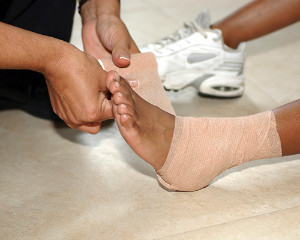 There are ligaments in the ankle that connect the feet to the bones. If one or more of these become stretched because of an injury, it may result in an ankle sprain. This can happen if the patient suddenly steps off of a curb, or falls from a loss of balance. There are noticeable symptoms that immediately appear if an ankle sprain has occurred. These can consist of severe pain, swelling, and it is often difficult to walk on. After a proper diagnosis is performed, which typically involves having an X-ray taken, the correct treatment can begin. This generally consists of wrapping the affected ankle in an elastic bandage, which may be helpful in providing the necessary support as the healing process takes place. It is suggested that the ankle is elevated as often as possible, as this may be beneficial in reducing a portion of the swelling. If you think you have sprained your ankle, please consult with a podiatrist as quickly as possible to begin treatment.
There are ligaments in the ankle that connect the feet to the bones. If one or more of these become stretched because of an injury, it may result in an ankle sprain. This can happen if the patient suddenly steps off of a curb, or falls from a loss of balance. There are noticeable symptoms that immediately appear if an ankle sprain has occurred. These can consist of severe pain, swelling, and it is often difficult to walk on. After a proper diagnosis is performed, which typically involves having an X-ray taken, the correct treatment can begin. This generally consists of wrapping the affected ankle in an elastic bandage, which may be helpful in providing the necessary support as the healing process takes place. It is suggested that the ankle is elevated as often as possible, as this may be beneficial in reducing a portion of the swelling. If you think you have sprained your ankle, please consult with a podiatrist as quickly as possible to begin treatment.
Ankle sprains are common but need immediate attention. If you need your feet checked, contact Dr. Michael D. Garvin from Florida. Our doctor can provide the care you need to keep you pain-free and on your feet.
How Does an Ankle Sprain Occur?
Ankle sprains take place when the ligaments in your ankle are torn or stretched beyond their limits. There are multiple ways that the ankle can become injured, including twisting or rolling over onto your ankle, putting undue stress on it, or causing trauma to the ankle itself.
What Are the Symptoms?
- Mild to moderate bruising
- Limited mobility
- Swelling
- Discoloration of the skin (depending on severity)
Preventing a Sprain
- Wearing appropriate shoes for the occasion
- Stretching before exercises and sports
- Knowing your limits
Treatment of a Sprain
Treatment of a sprain depends on the severity. Many times, people are told to rest and remain off their feet completely, while others are given an air cast. If the sprain is very severe, surgery may be required.
If you have suffered an ankle sprain previously, you may want to consider additional support such as a brace and regular exercises to strengthen the ankle.
If you have any questions please feel free to contact our offices located in Port St. Lucie, FL . We offer the newest diagnostic and treatment technologies for all your foot and ankle needs.
Warming up Before and After Running
 People who enjoy the sport of running are most likely familiar with the importance of properly warming up before and after each run. The ankles may become more stable when leg swings are practiced frequently, followed by performing hip circles. Research has indicated that running injuries may be prevented when you focus on a specific type of running, and train accordingly. These can consist of increasing speed, endurance, or running up and down hills. Practicing squats is an effective way of increasing the range of motion in your ankles, hips, and knees. If you would like additional information about how running injuries can affect the feet and how to prevent them, please consult with a podiatrist.
People who enjoy the sport of running are most likely familiar with the importance of properly warming up before and after each run. The ankles may become more stable when leg swings are practiced frequently, followed by performing hip circles. Research has indicated that running injuries may be prevented when you focus on a specific type of running, and train accordingly. These can consist of increasing speed, endurance, or running up and down hills. Practicing squats is an effective way of increasing the range of motion in your ankles, hips, and knees. If you would like additional information about how running injuries can affect the feet and how to prevent them, please consult with a podiatrist.
Exercising your feet regularly with the proper foot wear is a great way to prevent injuries. If you have any concerns about your feet, contact Dr. Michael D. Garvin of Florida. Our doctor will treat your foot and ankle needs.
How to Prevent Running Injuries
Many common running injuries are caused by overuse and overtraining. When the back of the kneecap starts wearing out and starts causing pain in your knee, this is commonly referred to as runner’s knee. Runner’s knee is a decrease in strength in your quadriceps and can occur if you’re not wearing properly fitted or supporting shoes. To prevent runner’s knee, focusing on hip strengthening is a good idea, as well as strengthening your quads to keep the kneecaps aligned.
What Are Some Causes of Running Injuries?
- One cause of a common running injury is called iliotibial band syndrome.
- Plantar fasciitis is also another common injury.
- Stress fractures can occur from overtraining, lack of calcium, or even your running style.
Best Ways to Prevent Running Injuries
- Wear footwear that fits properly and suits your running needs.
- Running shoes are the only protective gear that runners have to safeguard them from injury.
- Make a training schedule. Adding strengthening exercises as well as regular stretching can help keep you strong and limber and can lessen the possibility of injuries.
- Stretching keeps muscles limber; this will help you gain better flexibility.
If you have any questions please feel free to contact our offices located in Port St. Lucie, FL . We offer the newest diagnostic and treatment technologies for all your foot and ankle needs.
Exercising While Standing During the Work Day
People who have jobs that require standing for the majority of the day may be prone to developing foot conditions. There are groups of people who choose to stand at a computer work station for a living, and it is beneficial to incorporate successful strategies for foot health into the day. These can include maintaining a correct standing posture, which can consist of keeping the toes pointed forward, and ensuring that the foot is lying flat on the floor. It is helpful to walk for a short amount of time every hour, in addition to performing mobility exercises. These are a few methods that may help to keep your feet healthy during the work day, and it is suggested that you consult with a podiatrist to learn about the techniques that are best for you.
While working on the feet, it is important to take the proper care of them. For more information about working on your feet, contact Dr. Michael D. Garvin from Florida. Our doctor will treat your foot and ankle needs.
Working on Your Feet
Standing on your feet for long periods of time can cause stress and pain in your feet. Your whole body may experience change in terms of posture, back pain, bunions, callouses and or plantar warts. There are ways to avoid these conditions with proper foot care, smart choices and correct posture.
Positive Changes
Negative heeled shoe – Choosing this shoe type places the heel slightly lower than the ball of the foot. These are great for overall foot health. Find shoes that fit you correctly.
Go barefoot – Our feet were not designed to be enclosed for all hours of the day. Try to periodically expose your feet to air.
Eliminate Pain
Foot Exercises – Performing simple exercises, incorporating yoga and doing stretches are beneficial. This will allow increased blood flow to the area and muscles of the foot.
Achilles tendon – Stretching the foot out flat on the floor will relax the calf muscles and tendon. These exercises can be performed almost anywhere. Make sure you add these exercises to your daily regimen.
With a little bit of this information and knowing more about foot health, you will notice changes. Foot stretches and proper footwear will help with pain and prevent further issues.
If you have any questions please feel free to contact our offices located in Port St. Lucie, FL . We offer the newest diagnostic and treatment technologies for all your foot and ankle needs.
Guidelines for Purchasing New Shoes for Your Child
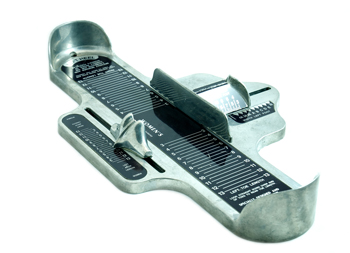 When purchasing new shoes for your children, there are general guidelines to follow that can help to ensure a proper fit. These can include shopping for shoes with your child present and wearing the socks that they intend to wear with their new shoes. It is important for the shoes to be roomy in both length and width, and that there is adequate support and cushioning. The heel should be rigid for maximum support, and although synthetic materials may be cheaper, it is better to go with quality materials such as leather or rubber. Additionally, it is beneficial to measure your child's feet before purchasing shoes. This can be accurately accomplished when a Brannock device is used. Shoes that fit properly for kids will feel comfortable when they are new, and they should not have to be broken in. It is important to make sure that there is ample room for the toes to move freely, as this may help to prevent painful foot conditions from developing. If you would like more information about purchasing shoes that fit correctly for your children, please consult with a podiatrist.
When purchasing new shoes for your children, there are general guidelines to follow that can help to ensure a proper fit. These can include shopping for shoes with your child present and wearing the socks that they intend to wear with their new shoes. It is important for the shoes to be roomy in both length and width, and that there is adequate support and cushioning. The heel should be rigid for maximum support, and although synthetic materials may be cheaper, it is better to go with quality materials such as leather or rubber. Additionally, it is beneficial to measure your child's feet before purchasing shoes. This can be accurately accomplished when a Brannock device is used. Shoes that fit properly for kids will feel comfortable when they are new, and they should not have to be broken in. It is important to make sure that there is ample room for the toes to move freely, as this may help to prevent painful foot conditions from developing. If you would like more information about purchasing shoes that fit correctly for your children, please consult with a podiatrist.
Finding a properly-fitting shoe is important in reducing injuries and preventing foot problems. For more information about treatment, contact Dr. Michael D. Garvin from Florida. Our doctor will treat your foot and ankle needs.
Proper Shoe Fitting
A common concern when it comes to foot health, having properly fitted shoes can help prevent injuries to the foot. Out feet affect our posture and gait, which in turn affects the biomechanics and overall bodily structure. With 33 joints, 26 bones, and over 100 ligaments, the potential for serious injury is much greater than one realizes. Although the feet cease growth in adulthood, they still change shape as they mature. Here are some factors to consider when it comes to investing in proper fitting shoes:
- Be sure the shoes fit correctly right away
- Ensure the ball of your foot fits comfortably in the widest portion of the shoes
- Even though they may look fashionable, improper fitting shoes can either create adverse conditions or exacerbate existing ones you may already have
- Walk along a carpeted surface to ensure the shoes comfortably fit during normal activity
Keeping in mind how shoes fit the biomechanics of your body, properly-fitting shoes are vitally important. Fortunately, it is not difficult to acquire footwear that fits correctly. Be sure to wear shoes that support the overall structure of your body. Do your feet a favor and invest in several pairs of well-fitted shoes today.
If you have any questions please feel free to contact our offices located in Port St. Lucie, FL . We offer the newest diagnostic and treatment technologies for all your foot and ankle needs.



